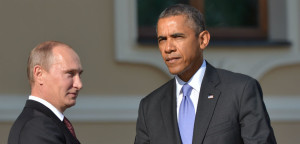The King and ISIS
King Salman came to Washington touting military and counterterrorism cooperation. But can the U.S.-Saudi relationship survive the House of Saud’s sponsorship of Islamic radicalism across the globe?
en Saudi Arabia’s King Salman made his first visit to Washington since ascending the throne in January, his goals were simple. The 79-year-old ruler wanted to paper over the disputes that have eroded the U.S.-Saudi relationship for years and extract from President Barack Obama’s administration a payoff for Riyadh’s tepid support of the nuclear deal with Iran. With the White House eager to maintain momentum on the nuclear agreement after securing the Senate votes to block the Republican rejection of the deal, King Salman’s timing was excellent — all but erasing memories of his no-show at a Camp David conference of Gulf leaders in May.
Papering over differences is one of diplomacy’s finer and more useful arts. With the Saudis anxious about a possible warming in the U.S. relationship with Iran and sharp disagreements regarding Syria, Egypt, Iraq, and the broader sectarian blood bath in the Middle East, the visit was a solid piece of work in the service of Washington’s ever more schizophrenic partnership with Riyadh — perhaps the most convoluted bilateral relationship the United States has had with any country. The atmospherics around the visit were sufficiently positive that few mentioned the contradictions that seem to be fraying ties between the United States and its longtime friend in the Gulf.
One commentator who did dwell on the deep dissonance in the relationship was Thomas Friedman, in a New York Times column published just before King Salman’s arrival. Teeing off on some benighted retired Air Force general who opposed the nuclear deal on the grounds that Iran was the leading sponsor of Islamic radicalism in the world, Friedman exclaimed: “Nothing has been more corrosive to the stability and modernization of the Arab world, and the Muslim world at large, than the billions and billions of dollars the Saudis have invested since the 1970s into wiping out the pluralism of Islam … and imposing in its place the puritanical, anti-modern, anti-women, anti-Western, anti-pluralistic Wahhabi Salafist brand of Islam.”
Friedman is on target in arguing that Saudi Arabia’s contribution to Islamist extremism has far outstripped Iran’s. Indeed, Tehran’s effort to transcend sect and become the leader of the Muslim world’s radical rejectionist stream has been in tatters since the Arab Spring and the heightening of sectarian tensions because of the Syrian civil war. Although systemic misgovernance is the Arab world’s deadliest disease, Saudi Arabia’s energetic propagation of Wahhabism — which began as a response to Iran’s Islamic Revolution in 1979 — has been central to the rise of violent extremism, from Indonesia to Mali.
Wahhabism has been a devastating invasive species in Islam’s enormous ecosystem — it’s the zebra mussel, the Asian Tiger mosquito, and the emerald ash borer wrapped into one. The consequences have been fateful: A solid line of causation from the slaughter in Islamic State-controlled Iraq and the tragedy of 9/11 traces back directly to Saudi evangelization and the many radical mosques and extremist NGOs it spawned.
Friedman’s explanation for why the United States has never challenged Riyadh is crude — in both senses of the word. “We’re addicted to their oil and addicts never tell the truth to their pushers,” he wrote.
This is too easy; if oil were the only vital U.S. interest binding it to the kingdom, dealing with the export of extremism would be vastly easier. What Friedman and almost everyone else misses is the increasingly pivotal importance of counterterrorism cooperation in the U.S.-Saudi relationship. That may set heads spinning, but when it comes to tactical counterterrorism — uncovering conspiracies and disrupting them — Saudi Arabia has become an invaluable partner, one of the very best Washington has.
Following Saudi Arabia’s apparent epiphany after the May 2003 bombings in Riyadh, which killed 39 people, ties between U.S. counterterrorism authorities and their Saudi counterparts have grown close, collegial, and effective. There is a reason why Interior Minister Mohammed bin Nayef, now second in line to the throne and the architect of Saudi counterterrorism strategy, is far and away Washington’s favorite leader in Riyadh.
The golden age of this cooperation began in 2009, when the terrorist threat was developing most dangerously in the kingdom’s backyard: Yemen. Saudi counterterrorism cooperation at the time prevented hundreds of American deaths, possibly more. Some of the cases are well-known, like the plot to hide bombs in printer cartridges aboard U.S.-bound planes. Without these tips, one or more aircraft would have gone down. Other operations have helped the United States defend against a new class of undetectable bombs that might also be used against aviation. Wherever else one might find fault with them, the Saudis did superb work in these cases.
The cooperation extends beyond the cloak and dagger stuff. Since 2003, the Saudi government’s work on counterterrorism finance has improved considerably, and its efforts in the area of rehabilitating extremists have been recognized internationally.
Still, there is an extraordinary paradox here. Because of the large sums that flow from the country’s religious establishment and huge NGOs to institutions that promote Wahhabi-style Islam — with its malignant views of Shiites, Jews, Christians, and the West — Saudi Arabia remains the fountainhead for Islamist extremism. These funds, together with curricular materials, preachers, television broadcasters, religious literature, and the like stoke radicalism in scores of countries, even if they are typically not directly implicated in violent acts. At the same time, Saudi intelligence services are active around the world trying to prevent the terrorism that grows from this activity.
Crazy? Absolutely, but it is an insanity borne of the kingdom’s original political compact between Muhammad ibn Saud, progenitor of the House of Saud, and Muhammad ibn Abd al-Wahhab, the original Wahhabi, a charismatic preacher — who joined forces to wrest control of the Arabian Peninsula in the mid-18th century. The royal family could rule Arabia so long as it promoted Wahhabism, and the monarchy has relied on Wahhabi clerics to validate its legitimacy as Custodian of the Two Holy Mosques ever since. Whenever the monarchy has faced challenges to its rule, it has pumped even more money to the clerical establishment, some of which went abroad. Not surprisingly, the prospect of a democratic wave sweeping the region during the Arab Spring led to billions being disbursed.
So why hasn’t the United States pressed Riyadh more effectively to dial back the support for extremism that so clearly affects our security and global interests?
There are several reasons. To begin with, counterterrorism cooperation of the kind that Riyadh has supplied is hard to argue with. No president wants to risk alienating a government that is helping safeguard American lives. While some officials have pushed for engaging the Saudis on the export of extremism, many others are averse to starting a tough discussion that could go nowhere. The Saudis, after all, are unlikely to reconceive their polity on our account.
Further complicating matters has been what might be called the “Politburo syndrome.” As with the Soviet Union in the 1980s, the small handful of Saudi gerontocrats who are authorized to do anything — either the king or a few of the senior-most princes — are either dying or too intellectually ossified to persuade anyone to adopt a radically different approach.
So for all the advances after 9/11 and the kiss-and-make-up atmosphere of the moment, the prognosis for the U.S.-Saudi relationship is not encouraging. The two countries’ priorities are simply too far apart.
For the United States, the imperatives are to implement the nuclear deal with Iran and halt the rise of Islamist extremism — above all, contain and diminish the Islamic State without dispatching American combat troops to the region. For the Saudis, the paramount goal is to check and roll back what they see as Iranian advances, especially in Yemen and Syria.
In Yemen, the Saudi campaign against the Houthi insurgents has become the signature initiative for Riyadh’s new and emboldened foreign policy. The United States has voiced hedged support for the Saudi effort — primarily an effort at alliance maintenance, which was a necessity against the backdrop of the nuclear negotiations.
But behind the scenes, Washington has gnawing concerns about the Saudi war effort. The bombing runs are killing civilians in appalling numbers, and a country that hovers on desperation has been plunged into a humanitarian disaster. The United States is trying to refine Saudi targeting, but the carnage remains ghastly, and the Saudi claim that the Houthis are nothing more than an Iranian proxy has also worn thin.
This isn’t just bad for the Yemenis. It’s also bad for the United States because terrorist groups thrive in conflict zones and Yemen’s jihadis — especially al Qaeda — are gaining territory and influence, since they face no pressure except from the occasional U.S. drone shot.
Meanwhile in Syria, the Saudis are not supporting the Islamic State, but they would be quite happy to see other Islamists topple Bashar al-Assad and make Damascus again a Sunni capital. Plenty of money is now flowing from the Persian Gulf to al-Nusra Front, the al Qaeda affiliate in Syria. Again, extremists are benefiting from the chaos.
As for the U.S.-led coalition fighting against the Islamic State, the Saudi contribution has been minimal. It hasn’t flown a mission in Iraq yet, according to the accounting on the Pentagon’s website. Exactly why is not clear: Perhaps the Saudis can’t ask for permission from the Shiite-dominated Iraqi government because they don’t have an embassy in Baghdad, or perhaps they just can’t bring themselves to support the Baghdad government. In Syria, it has flown a scant few of the 119 airstrikes not carried out by the United States. In short, Riyadh believes that the extremist problem can be cleaned up later — after it wins the wars in Yemen and Syria and puts Iran back in its place.
Can any of this be fixed? Will our partners of seven decades, as U.S. officials like to refer to the Saudis, join in the fight against extremism and not just its terrorist end-product? Don’t count on it: Saudi Arabia has avoided taking such steps for decades, and there is no reason to think the kingdom can’t stay on its current course for decades more.
As for the United States, it will remain saddled with tactical imperatives that prevent it from addressing the bigger mess. And so Washington will muddle forward against the jihadi threat.
In: foreignpolicy








